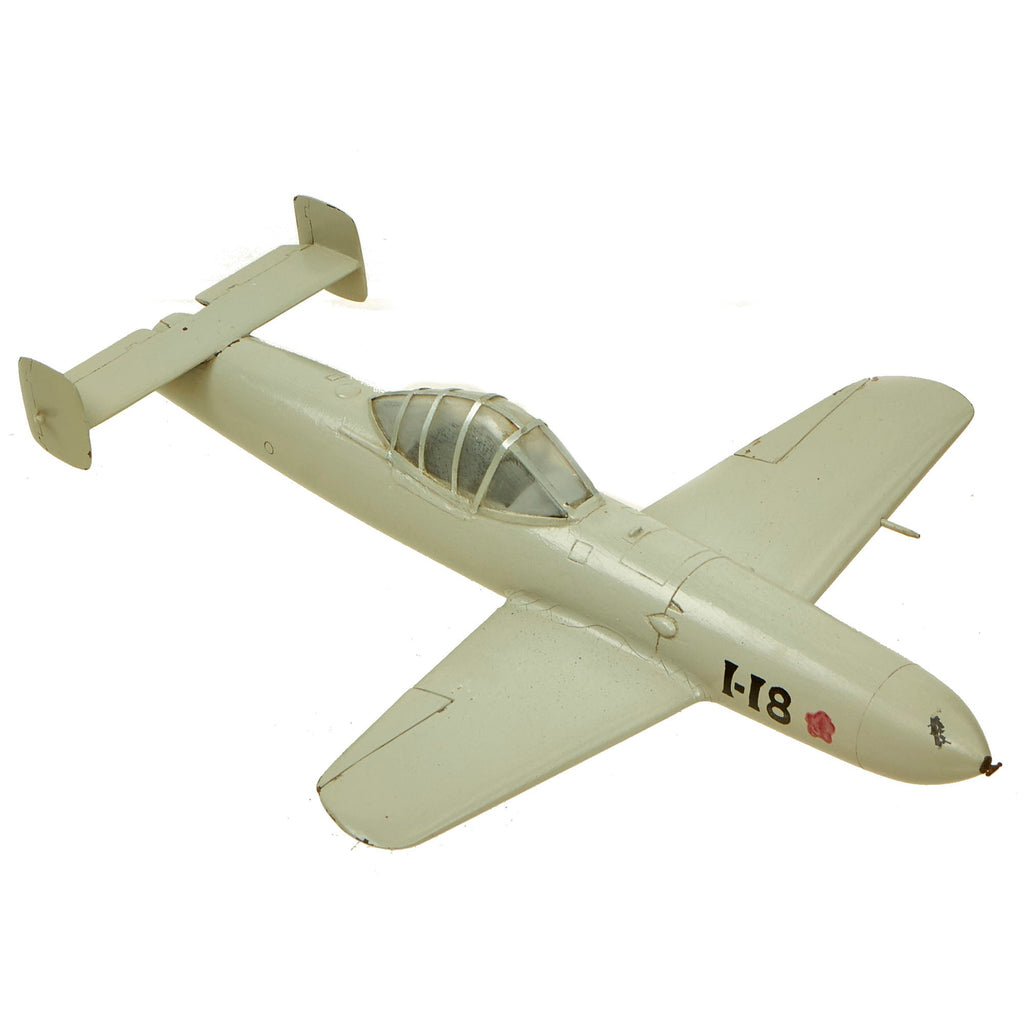Item Description
Original Item: Only One Available. Now this is a wonderful, yet dark piece of WWII history. This wooden aircraft model would have been utilized in a classroom environment to train pilots to conduct anti-ship Kamikaze missions. Kamikaze, officially Shinpū Tokubetsu Kōgekitai, were a part of the Japanese Special Attack Units of military aviators who flew suicide attacks for the Empire of Japan against Allied naval vessels in the closing stages of the Pacific campaign of World War II, intending to destroy warships more effectively than with conventional air attacks. About 3,800 kamikaze pilots died during the war, and more than 7,000 naval personnel were killed by kamikaze attacks.
The Yokosuka MXY-7 Ohka “Cherry Blossom”, was a purpose-built, rocket-powered human-guided kamikaze attack aircraft employed by Japan against Allied ships towards the end of the Pacific War during World War II. Although extremely fast, the very short range of the Ohka meant that it had to be carried into action as a parasite aircraft by a much larger bomber, which was itself vulnerable to carrier-borne fighters. In action during the Battle of Okinawa in 1945, Ohkas were able to sink or damage some escort vessels and transport ships but no major warships were ever sunk. Improved versions which attempted to overcome the aircraft's shortcomings were developed too late to be deployed. Allied troops referred to the aircraft as "Baka Bombs".
The aircraft is constructed of solid wood and features what appears to be original period paint. The model appears to be complete and not missing any pieces. The wingspan measures 12” with a total length of 15 ¼”. There is minor cracking present but nothing too damaging that affects the displayability of the model.
A rare model that comes more than ready for further research and display.
The Yokosuka MXY7 Ohka was used mostly against U.S. ships invading Okinawa, and if launched from its mothership, could be effective because of its high speed in the dive. In the first two attempts to transport the Ohkas to Leyte Gulf using aircraft carriers, the carriers Shinano and Unryu were sunk by the U.S. submarines Archerfish and Redfish.
Attacks intensified in April 1945. On 1 April 1945, six G4Ms attacked the U.S. fleet off Okinawa. At least one made a successful attack; its Ohka was thought to have hit one of the 406 mm (16 in) turrets on the battleship West Virginia, causing moderate damage. Postwar analysis indicated that no hits were recorded and that a near-miss took place. The transports Alpine, Achernar, and Tyrrell were also hit by kamikaze aircraft, but it is unclear whether any of these were Ohkas from the other G4Ms. None of the G4Ms returned.
The U.S. military quickly realized the danger and concentrated on extending their "defensive rings" outward to intercept the G4M/Ohka combination aircraft before the suicide mission could be launched. On 12 April 1945, nine G4Ms attacked the U.S. fleet off Okinawa. The destroyer Mannert L. Abele was hit, broke in two, and sank. Jeffers destroyed an Ohka with AA fire 45 m (50 yd) from the ship, but the resulting explosion was still powerful enough to cause extensive damage, forcing Jeffers to withdraw. The destroyer Stanly was attacked by two Ohkas. One struck above the waterline just behind the ship's bow, its charge passing completely through the hull and splashing into the sea, where it detonated underwater, causing little damage to the ship. The other Ohka narrowly missed (its pilot probably killed by anti-aircraft fire) and crashed into the sea, knocking off the Stanly's ensign in the process. One Betty returned. On 14 April 1945, seven G4Ms attacked the U.S. fleet off Okinawa. None returned. None of the Ohkas appeared to have been launched. Two days later, six G4Ms attacked the U.S. fleet off Okinawa. Two returned, but no Ohkas had hit their targets. Later, on 28 April 1945, four G4Ms attacked the U.S. fleet off Okinawa at night. One returned. No hits were recorded.
May 1945 saw another series of attacks. On 4 May 1945, seven G4Ms attacked the U.S. fleet off Okinawa. One Ohka hit the bridge of a destroyer, Shea, causing extensive damage and casualties. Gayety was also damaged by an Ohka's near miss. One G4M returned. On 11 May 1945, four G4Ms attacked the U.S. fleet off Okinawa. The destroyer Hugh W. Hadley was hit and suffered extensive damage and flooding. The vessel was judged beyond repair. On 25 May 1945, 11 G4Ms attacked the fleet off Okinawa. Bad weather forced most of the aircraft to turn back, and none of the others hit targets.
On 22 June 1945, six G4Ms attacked the fleet. Two returned, but no hits were recorded. Postwar analysis concluded that the Ohka's impact was negligible, since no U.S. Navy capital ships had been hit during the attacks because of the effective defensive tactics that were employed. In total, of the 300 Ohka available for the Okinawa campaign, 74 actually undertook operations, of which 56 were either destroyed with their parent aircraft or in making attacks. The Allied nickname for the aircraft was "Baka", a Japanese word meaning "foolish" or "idiotic".
- This product is available for international shipping.
- Eligible for all payments - Visa, Mastercard, Discover, AMEX, Paypal & Sezzle









